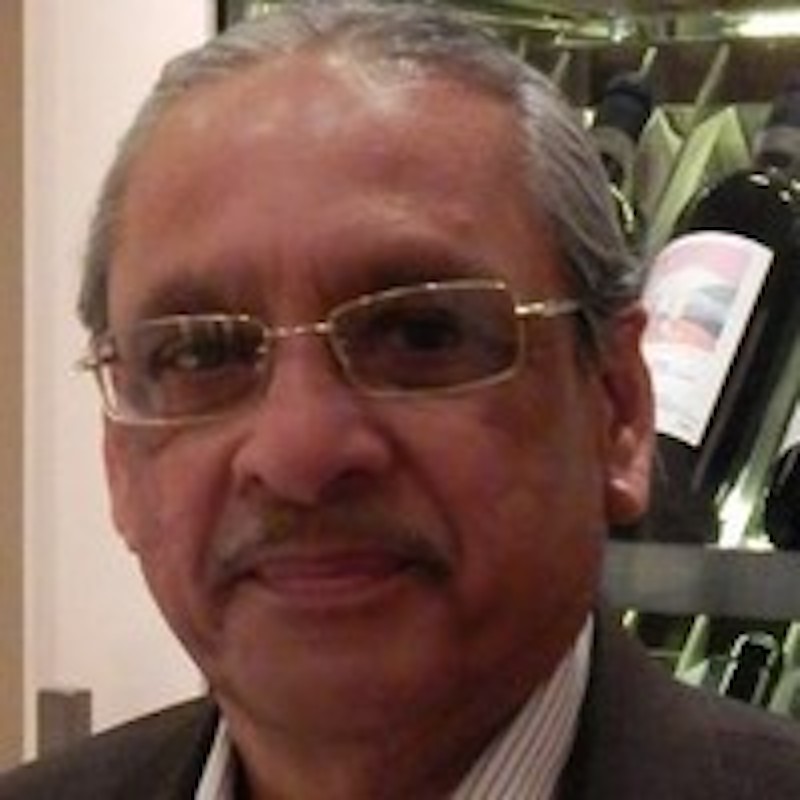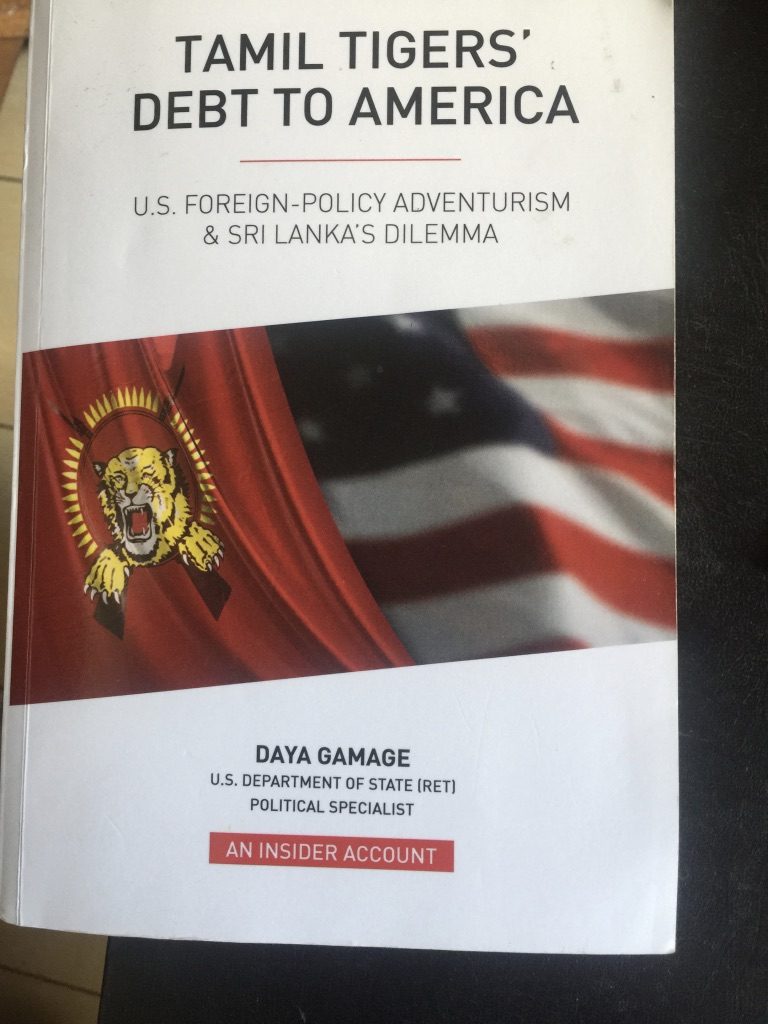Daya Gamage worked at the American Embassy in Colombo, as the Sole Foreign Service National and a Political Specialist. He retired in 1994 and has been living in Las Vegas since retirement. After two years of concentration, he has been able to share his knowledge, understanding and his intimate professional association with the US Department of State in the form of a book – ‘Tamil Tigers’ Debt to America’. Being aware of how America’s foreign policy worked- sometimes in a strange manner, he has come out with an unbiased text full of data in his book nowhere else is contained. Daya Gamage has authorised the writer to ” to quote anything from his book” so that the readers will get a clear picture of America’s Foreign Policy, Sri Lanka’s National Issues and the LTTE struggle in depth. Gamage handles the United States Bureau of the Online daily newspaper Asian Tribune constantly making the readers knowledgeable of the U.S. foreign policy towards Third World Nations works. His book is available at Amazon.

——————————————————————————————————————–
‘During the 1990s at the Chief Executive’s office in the US Embassy in Colombo, a group of Foreign Service Officers had a routine meeting to exchange notes of significant developments in Sri Lanka’s political scenario. Daya Gamage, in his capacity as the Diplomatic Mission’s Political Specialist and a Senior Foreign Service National (FSN) with near-midlevel security clearance, was an inevitable attendee that discussed issues well beyond midlevel clearance.
At the time of this meeting, Sri Lanka’s political atmosphere was volatile as in the previous November ( 1989), the Sinhala-Nationalist Marxist insurrection of the Janatha Vimukthi Peramuna ( JVP, aka Peoples’ Liberation Front, was brutally crushed and its charismatic leader, Rohana Wijeweera along with a few of his lieutenants were allegedly cremated alive at the Colombo’s crematorium ( Kanatta) supervised by the top gear of the military and a heavyweight who handled national security of the Premadasa Administration. The memories of the brutal killings of thousands of youth alleged to have participated in the JVP insurrection or sympathisers of the movement or suspected to be in league with the nationwide rebellion were still lingering in the minds of foreign diplomats, and the insurrection in the North by the Liberation of Tigers of Tamil Eelam (LTTE/Tamil Tigers) was in full swing where the Tigers were controlling a large swath of land in the predominantly Tamil North and the East. FSOs in the Colombo embassy were continuing to dispatch a weekly diplomatic cable to Washington, the D & D ( for ” death and destruction”), of terrorist incidents and fighting throughout the island.
Daya Gamage’s Field Tour
A week after the questionable demise of the JVP leader Wijeweera in November 19089, Daya Gamage has undertaken a three-day field tour in the heartland of the JVP insurrection, the Deep South District of Hambantota to meet and interact with the regional JVP activists who were still maintaining their grip in remote localities. This field tour was made possible by the government agent of the district at that time, who was a contemporary of Daya Gamage at the University of Ceylon, Peradeniya, in the 1960s. What Daya Gamage had learnt during such field tours were shared with the FSOs at such meetings, discussed and analysed for Washington consumption.
‘The early 1990 meeting at the US embassy did not focus much on the brutal suppression of the JVP or what Daya Gamage presented on that grave issue. Special emphasis was placed on the Northern separatist warfare of the LTTE. Tamil rights and grievances and the military offensive were other issues. Suddenly, one FSO declared, ” The Sinhala army is killing the Tamils“.
It was not an earth-shattering discovery for the FSO cadre at the US embassy in Colombo to air such an outburst. The American diplomats were already convinced that the minority Tamils had had a raw deal under the ” chauvinistic Sinhala regimes” and that the birth of the Tamil Tigers was the result of that treatment.
The above mentioned FSO was, in fact, expressing a sentiment that became a part of the mind-set of Washington and among the Colombo based American diplomats. With such sentiments, the blatant human-rights abuses during the brutal suppression of the JVP insurrection with mass-scale massacres throughout Sri Lanka were put on the back burner. The existence of torture chambers, one of which was located at Batalanda in the Biyagama electoral district represented by a prominent politician in the Jayawardene administration, was not important to the Americans!
Mahinda Rajapaksa’s Representation
The constant representations made by the opposition parliamentarians Mahinda Rajapaksa and Mangala Samaraweera to American diplomats went unheeded. Ambassador Creekmore was very unhappy when Mangala Samaraweera showed his displeasure about the failure of the US embassy and Washington to seriously take note of the blatant human rights violations during the 1988/1989 crackdown on the JVP insurrection when the two met in early 1990 in Matara. Daya Gamage had accompanied the Ambassador on the fact-finding tour in the Southern districts.
Irritated by this ” declaration” stated above, Daya Gamage had wanted those who were at the meeting to give a breakdown of the ethnic ratio of the three groups: the fighting cadres of the JVP, LTTE and the Sri Lanka military. The consensus was that the LTTE fighting cadre composed of 100 per cent minority Tamils; JVP’s fighting cadre consisted of 100 per cent of Sinhalese; and the Government military was composed of approximately 90 per cent of Sinhalese. With that breakdown, Daya Gamage had wanted a reasonable interpretation to the reality: the Sinhala Army was killing the Tamil rebels as much as they had killed the Sinhala rebels, the latter massacres being the worse.
What Daya Gamage had witnessed during his tenure as the political specialist of the US Diplomatic Mission in Colombo, Sri Lanka during the 1980s and 1990s was the excessive interest by the State Department and its diplomatic corps in Colombo exhibited during that period on Tamil issues and grievances. The interest never extended to the human rights violations that occurred during the Government of Sri Lanka’s brutal military suppression against the JVP insurrection.
Daya Gamage has since found out new evidence in published scholarly works that Americans turned a blind eye on the brutal killings of the Sinhala youth by the military of the pro-Western Jayawardene administration. There was a direct battle. The JVP fighting cadre possessed the most primitive weapons. Most who were summarily executed after undergoing brutal torture were youths who had marginal connections with the JVP or were innocent bystanders. In contrast, the Tamil Tigers, who possessed sophisticated weaponry, used unarmed Tamil civilians as human fodder. The US State Department took a soft attitude towards the conservative, pro-United States administration of J.R.Jayawardene, under whose watch thousands of Sinhala youths were massacred and tortured during the JVP-inspired nationwide insurrection of 1988/89.

Teresita S. Schaffer, the deputy assistant secretary (1989-1992) for South Asia in Washington made the following remarks in September 1998 to Thomas Stern who interviewed her for the Foreign Affairs Oral History Project of The Association for Diplomatic Studies and training
Teresita S. Schaffer’s remarks.
” The US in the 1989-92 period had human rights high on its foreign policy agenda. In the case of Sri Lanka, it was an awkward situation because that country’s record was deplorable. I am not just referring to the actions against the LTTE or the JVP; in Sri Lanka almost, everybody’s human rights were being violated. At one time, Sri Lanka held the world’s record of disappearances. There were also widespread reports of torture of the accused members of either the LTTE or the JVP. The US was critical of the Sri Lankan Government’s human rights record; at the same time, we understand the challenges that the government was facing. When it came to time for the annual human rights report, the Assistant Secretary for Human Rights was so revolted by the JVP that he wanted to take much softer public line than the post or the bureau- a very unusual situation. We had to point out to him that the US Government had to mention certain specific Sri Lankan violations because they would be raised in Geneva and we would look foolish if we overlooked at them.
The United States had an administration (Jayawardene 1977-1989) of its choice- a pro-Western in general and pro-United States in particular, which liberalised the economy at the behest of the United States and supported all US foreign-policy initiatives. President Jayawardene lived up to his nickname (given in the 1950s) ” Yankee Dickey.” ( He was Junius Richard Jayawardene, and those close to him addressed him as Dicky). The United States failed to understand the challenges that Rajapaksa government was facing during the final months of the LTTE battle, in the words of Mrs Schaffer, the United States ” understood the challenges that the government was facing” – the government of JR Jayawardena- not to press on disappearances, extrajudicial killings, and other crimes against the JVP and the LTTE. The UNHRC never existed, and Geneva was another city on the global map.
During the 1988/1999 Marxist JVP nationwide insurrection, parliamentarians Mahinda Rajapaksa and
Mangala Samaraweera often contacted the US embassy officials, in some instances through Daya Gamage and other times on their own, to apprise them of the blatant human rights violations that were taking place. In most occasions, Daya Gamage, who knew both parliamentarians quite well, engaged in separate discourses to inform the Diplomatic Mission.
A diplomatic cable on November 21, 2005, to Washington signed by Ambassador Jeffrey L. Lunstead, noted the discourses the American officials had during that time with the two parliamentarians. Provided here is the diplomatic cable written by Ambassador Lunstead recalling those discourses in late 1980 and early 1990.
“Confidential Section 01 of 04 Colombo 001981 – SIPDIS – E.O.12958: DEC: 11/20/2015 – TAGS: PINR PGOVCE-
SUBJECT: SRI LANKA: BIOGRAPHIC INFORMATION ON PRESIDENT MAHINDA RAJAPAKSA;
REF: A. COLOMBO 1853 -B.COLOMBO 1975 – Classified by: AMB.JEFFREY J. LUNSTEAD. REASON 1.4 (B,D).”
Courtesy: Daya Gamage – ” Tamil Tigers’ Debt to America”
To be continued: ‘ Defender of JVP Missing.
picture credit: Daya Gamage’s book






